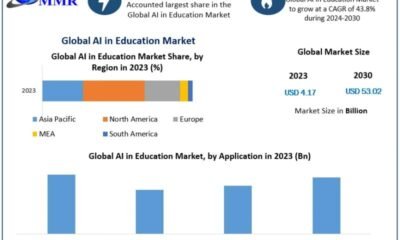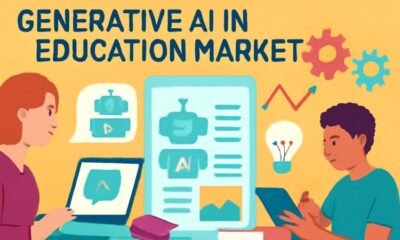AI Insights
Global Artificial Intelligence (AI) in Clinical Trials Market

According to DelveInsight’s analysis, The demand for Artificial Intelligence in clinical trials is experiencing strong growth, primarily driven by the rising global prevalence of chronic conditions like diabetes, cardiovascular diseases, respiratory illnesses, and cancer. This growth is further supported by increased investments and funding dedicated to advancing drug discovery and development efforts. Additionally, the growing number of strategic collaborations and partnerships among pharmaceutical, biotechnology, and medical device companies is significantly boosting the adoption of AI-driven solutions in clinical trials. Together, these factors are anticipated to fuel the expansion of the AI in the clinical trials market during the forecast period from 2025 to 2032.
DelveInsight’s “Artificial Intelligence (AI) in Clinical Trials Market Insights, Competitive Landscape and Market Forecast-2032” report provides the current and forecast market outlook, forthcoming device innovation, challenges, market drivers and barriers. The report also covers the major emerging products and key Artificial Intelligence (AI) in Clinical Trials companies actively working in the market.
To know more about why North America is leading the market growth in the Artificial Intelligence (AI) in Clinical Trials market, get a snapshot of the report Artificial Intelligence (AI) in Clinical Trials Market Trends
https://www.delveinsight.com/sample-request/ai-in-clinical-trials-market?utm_source=openpr&utm_medium=pressrelease&utm_campaign=gpr
Artificial Intelligence (AI) in Clinical Trials Overview
Artificial Intelligence (AI) in clinical trials refers to the use of advanced machine learning algorithms and data analytics to streamline and improve various aspects of clinical research. AI enhances trial design, patient recruitment, site selection, and data analysis by identifying patterns and predicting outcomes. It enables faster patient matching, optimizes protocol design, reduces trial timelines, and improves data quality and monitoring. AI also helps in real-time adverse event detection and adaptive trial management, making clinical trials more efficient, cost-effective, and patient-centric.
DelveInsight Analysis: The global Artificial Intelligence in clinical trials market size was valued at USD 1,350.79 million in 2024 and is projected to expand at a CAGR of 12.04% during 2025-2032, reaching approximately USD 3,334.47 million by 2032.
Artificial Intelligence (AI) in Clinical Trials Market Insights
Geographically, North America is expected to lead the AI in the clinical trial market in 2024, driven by several critical factors. The region’s growing burden of chronic diseases, substantial investments in R&D, and the rising volume of clinical trials contribute significantly to this dominance. Additionally, an increasing number of collaborations and partnerships among pharmaceutical and medical device companies, along with the advancement of sophisticated AI solutions, are accelerating market expansion. These developments are enhancing the ability to manage complex clinical trials efficiently, driving the adoption of AI technologies and supporting the market’s growth in North America throughout the forecast period from 2025 to 2032.
To read more about the latest highlights related to Artificial Intelligence (AI) in Clinical Trials, get a snapshot of the key highlights entailed in the Artificial Intelligence (AI) in Clinical Trials
https://www.delveinsight.com/report-store/ai-in-clinical-trials-market?utm_source=openpr&utm_medium=pressrelease&utm_campaign=gpr
Recent Developments in the Artificial Intelligence (AI) in Clinical Trials Market Report
• In May 2025, Avant Technologies, Inc. (OTCQB: AVAI) and joint venture partner Ainnova Tech, Inc. announced the initiation of acquisition discussions aimed at enhancing their presence in the rapidly growing AI-powered healthcare sector.
• In March 2025, Suvoda introduced Sofia, an AI-driven assistant created to optimize clinical trial management processes. Sofia aids study teams by providing quick access to essential trial data and real-time, intelligent insights. This tool boosts operational efficiency, minimizes manual tasks, and helps teams make faster, data-informed decisions throughout the clinical trial journey.
• In December 2024, ConcertAI and NeoGenomics unveiled CTO-H, an advanced AI-powered software platform designed to enhance research analytics, clinical trial design, and operational efficiency. CTO-H provides an extensive research data ecosystem, offering comprehensive longitudinal patient data, deep biomarker insights, and scalable analytics to support more precise, efficient, and data-driven clinical development processes.
• In June 2024, Lokavant introduced SpectrumTM, the first AI-powered clinical trial feasibility solution aimed at enhancing trial performance throughout the clinical development process. Spectrum enables study teams to forecast, control, and improve trial timelines and expenses in real-time.
• Thus, owing to such developments in the market, rapid growth will be observed in the Artificial Intelligence (AI) in Clinical Trials market during the forecast period
Key Players in the Artificial Intelligence (AI) in Clinical Trials Market
Some of the key market players operating in the Artificial Intelligence (AI) in Clinical Trials market include- TEMPUS, NetraMark, ConcertAI, AiCure, Medpace, Inc., ICON plc, Charles River Laboratories, Dassault Systèmes, Oracle, Certara, Cytel Inc., Phesi, DeepHealth, Unlearn.ai, Inc., H1, TrialX, Suvoda LLC, Risklick, Lokavant, Research Solutions, and others.
Which MedTech key players in the Artificial Intelligence (AI) in Clinical Trials market are set to emerge as the trendsetter explore @ Key Artificial Intelligence (AI) in Clinical Trials Companies
https://www.delveinsight.com/sample-request/ai-in-clinical-trials-market?utm_source=openpr&utm_medium=pressrelease&utm_campaign=gpr
Analysis on the Artificial Intelligence (AI) in Clinical Trials Market Landscape
To meet the growing needs of clinical trials, leading companies in the AI in Clinical Trials market are creating advanced AI solutions aimed at improving trial efficiency, optimizing patient recruitment, and enhancing clinical trial design at investigator sites. For example, in April 2023, ConcertAI introduced CTO 2.0, a clinical trial optimization platform that utilizes publicly available data and partner insights to deliver comprehensive site and physician-level trial data. This tool provides key operational metrics and site profiles to evaluate trial performance and site capabilities. Additionally, CTO 2.0 assists sponsors in complying with FDA requirements for inclusive trial outcomes, promoting a shift toward community-based trials with more streamlined and patient-centric designs.
As a result of these advancements, the software segment is projected to experience significant growth throughout the forecast period, contributing to the overall expansion of the AI in the clinical trials market.
Scope of the Artificial Intelligence (AI) in Clinical Trials Market Report
• Coverage: Global
• Study Period: 2022-2032
• Artificial Intelligence (AI) in Clinical Trials Market Segmentation By Product Type: Software and Services
• Artificial Intelligence (AI) in Clinical Trials Market Segmentation By Technology Type: Machine Learning (ML), Natural Language Processing (NLP), and Others
• Artificial Intelligence (AI) in Clinical Trials Market Segmentation By Application Type: Clinical Trial Design & Optimization, Patient Identification & Recruitment, Site Identification & Trial Monitoring, and Others
• Artificial Intelligence (AI) in Clinical Trials Market Segmentation By Therapeutic Area: Oncology, Cardiology, Neurology, Infectious Disease, Immunology, and Others
• Artificial Intelligence (AI) in Clinical Trials Market Segmentation By End-User: Pharmaceutical & Biotechnology Companies and Medical Device Companies
• Artificial Intelligence (AI) in Clinical Trials Market Segmentation By Geography: North America, Europe, Asia-Pacific, and Rest of the World
• Key Artificial Intelligence (AI) in Clinical Trials Companies: TEMPUS, NetraMark, ConcertAI, AiCure, Medpace, Inc., ICON plc, Charles River Laboratories, Dassault Systèmes, Oracle, Certara, Cytel Inc., Phesi, DeepHealth, Unlearn.ai, Inc., H1, TrialX, Suvoda LLC, Risklick, Lokavant, Research Solutions, and others
• Porter’s Five Forces Analysis, Product Profiles, Case Studies, KOL’s Views, Analyst’s View
Interested in knowing how the Artificial Intelligence (AI) in Clinical Trials market will grow by 2032? Click to get a snapshot of the Artificial Intelligence (AI) in Clinical Trials Market Analysis
https://www.delveinsight.com/sample-request/ai-in-clinical-trials-market?utm_source=openpr&utm_medium=pressrelease&utm_campaign=gpr
Table of Contents
1 Artificial Intelligence (AI) in Clinical Trials Market Report Introduction
2 Artificial Intelligence (AI) in Clinical Trials Market Executive summary
3 Regulatory and Patent Analysis
4 Artificial Intelligence (AI) in Clinical Trials Market Key Factors Analysis
5 Porter’s Five Forces Analysis
6 COVID-19 Impact Analysis on Artificial Intelligence (AI) in Clinical Trials Market
7 Artificial Intelligence (AI) in Clinical Trials Market Layout
8 Global Company Share Analysis – Key Artificial Intelligence (AI) in Clinical Trials Companies
9 Company and Product Profiles
10 Project Approach
11 Artificial Intelligence (AI) in Clinical Trials Market Drivers
12 Artificial Intelligence (AI) in Clinical Trials Market Barriers
13 About DelveInsight
Latest Reports by DelveInsight
• Percutaneous Arterial Closure Device Market: https://www.delveinsight.com/report-store/vascular-closure-devices-market
• Transdermal Drug Delivery Devices: https://www.delveinsight.com/report-store/transdermal-drug-delivery-devices-market
• Infusion Pumps Market: https://www.delveinsight.com/report-store/infusion-pumps-market
• Acute Radiation Syndrome Market: https://www.delveinsight.com/report-store/acute-radiation-syndrome-pipeline-insight
• Human Papillomavirus Hpv Market: https://www.delveinsight.com/report-store/human-papillomavirus-hpv-market
• Blood Gas And Electrolyte Analyzers Market: https://www.delveinsight.com/report-store/blood-gas-and-electrolyte-analyzers-market
Contact Us
Gaurav Bora
info@delveinsight.com
+14699457679
www.delveinsight.com
Connect With Us at:
LinkedIn | Facebook | Twitter
About DelveInsight
DelveInsight is a leading Business Consultant and Market Research firm focused exclusively on life sciences. It supports Pharma companies by providing end-to-end comprehensive solutions to improve their performance.
Get hassle-free access to all the healthcare and pharma market research reports through our subscription-based platform PharmDelve.
This release was published on openPR.
AI Insights
Vikings vs. Falcons props, bets, SportsLine Machine Learning Model AI predictions: Robinson over 68.5 rushing

Week 2 of Sunday Night Football will see the Minnesota Vikings (1-0) hosting the Atlanta Falcons (0-1). J.J. McCarthy and Michael Penix Jr. will be popular in NFL props, as the two will face off for the first time since squaring off in the 2023 CFP National Title Game. The cast of characters around them has changed since McCarthy and Michigan prevailed over Washington, as the likes of Justin Jefferson, Kyle Pitts, T.J. Hockenson, and Drake London now flank the quarterbacks. There are several NFL player props one could target for these star players, or you may find value in going after under-the-radar options.
Tyler Allgeier had 10 carries in Week 1, which were just two fewer than Bijan Robinson, with the latter being more involved in the passing game with six receptions. If Allgeier has a similar type of volume going forward, then the over for his rushing yards NFL prop may be one to consider. A strong run game would certainly help out a young quarterback like Penix, so both Allgeier and Robinson have intriguing Sunday Night Football props. Before betting any Falcons vs. Vikings props for Sunday Night Football, you need to see the Vikings vs. Falcons prop predictions powered by SportsLine’s Machine Learning Model AI.
Built using cutting-edge artificial intelligence and machine learning techniques by SportsLine’s Data Science team, AI Predictions and AI Ratings are generated for each player prop.
For Falcons vs. Vikings NFL betting on Sunday Night Football, the Machine Learning Model has evaluated the NFL player prop odds and provided Vikings vs. Falcons prop picks. You can only see the Machine Learning Model player prop predictions for Atlanta vs. Minnesota here.
Top NFL player prop bets for Falcons vs. Vikings
After analyzing the Vikings vs. Falcons props and examining the dozens of NFL player prop markets, the SportsLine’s Machine Learning Model says Falcons RB Bijan Robinson goes Over 68.5 rushing yards (-114 at FanDuel). Robinson ran for 92 yards and a touchdown in Week 14 of last season versus Minnesota, despite the Vikings having the league’s No. 2 run defense a year ago. After replacing their entire starting defensive line in the offseason, it doesn’t appear the Vikings are as stout on the ground. They allowed 119 rushing yards in Week 1, which is more than they gave up in all but four games a year ago.
Robinson is coming off a season with 1,454 rushing yards, which ranked third in the NFL. He averaged 85.6 yards per game, and not only has he eclipsed 65.5 yards in six of his last seven games, but he’s had at least 90 yards on the ground in those six games. Over Minnesota’s last eight games, including the postseason, six different running backs have gone over 65.5 rushing yards, as the SportsLine Machine Learning Model projects Robinson to have 85.6 yards in a 4.5-star prop pick. See more NFL props here, and new users can also target the FanDuel promo code, which offers new users $300 in bonus bets if their first $5 bet wins:
How to make NFL player prop bets for Minnesota vs. Atlanta
In addition, the SportsLine Machine Learning Model says another star sails past his total and has five additional NFL props that are rated four stars or better. You need to see the Machine Learning Model analysis before making any Falcons vs. Vikings prop bets for Sunday Night Football.
Which Vikings vs. Falcons prop bets should you target for Sunday Night Football? Visit SportsLine now to see the top Falcons vs. Vikings props, all from the SportsLine Machine Learning Model.
AI Insights
Prediction: These AI Stocks Could Outperform the “Magnificent Seven” Over the Next Decade

The “Magnificent Seven” stocks, which drove indexes higher over the past couple of years, continued that job in recent months. And for good reason. Most of these tech giants are playing key roles in the high-growth industry of artificial intelligence (AI), a market forecast to reach into the trillions of dollars by the early 2030s. Investors, wanting to benefit from this growth, have piled into these current and potential AI winners.
But the Magnificent Seven stocks aren’t the only ones that may be set to excel in AI and deliver growth to investors. As the AI story progresses, the need for infrastructure capacity and certain equipment could result in surging sales for other companies too. That’s why my prediction is the following three stocks are on track for major strength in AI and may even outperform the Magnificent Seven over the coming decade. Let’s check them out.
Image source: Getty Images.
1. Oracle
Oracle (ORCL -5.05%) started out as a database management specialist, and it still is a giant in this area, but in recent times it’s put the focus on growing its cloud infrastructure business — and this has supercharged the company’s revenue.
AI customers are rushing to Oracle for capacity to run training and inferencing workloads, and this movement helped the company report a 55% increase in infrastructure revenue in the recent quarter. And Oracle predicts this may be just the beginning. The company expects this business to deliver $18 billion in revenue this year — and grow that to $144 billion four years from now.
Investors were so excited about Oracle’s forecasts that the stock surged about 35% in one trading session, adding more than $200 billion in market value. Customers are seeing the value of Oracle’s database technology paired with AI — a combination that allows them to securely apply AI to their businesses — and this may keep the demand for Oracle’s services going strong and the stock price heading higher as the AI story enters its next chapters.
2. CoreWeave
CoreWeave (CRWV -0.65%) has designed its cloud platform specifically for AI workloads, and the company works closely with chip leader Nvidia. So far, this has resulted in CoreWeave’s being the first to make Nvidia’s latest platforms generally available to customers. This is a big plus as companies scramble to gain access to Nvidia’s innovations as soon as possible.
Nvidia also is a believer in CoreWeave’s potential as the chip giant holds shares in the company. As of the second quarter, CoreWeave makes up 91% of Nvidia’s investment portfolio. Considering Nvidia’s knowledge of the AI landscape, this investment is particularly meaningful.
Customers may also like the flexibility of CoreWeave’s services, allowing them to rent graphics processing units (GPUs) by the hour or for the long term. All of this has led to explosive revenue growth for the company. In the latest quarter, revenue tripled to more than $1.2 billion.
The growing need for AI infrastructure should translate into ongoing explosive growth for CoreWeave, and that may make it a stronger stock market performer than long-established players — such as the Magnificent Seven.
3. Broadcom
Broadcom (AVGO 0.19%) is a networking leader, with its products present in a variety of places from your smartphone to data centers. And in recent times, demand from AI customers — for items such as customized chips and networking equipment — has helped revenue soar.
In the recent quarter, Broadcom said AI revenue jumped 63% year over year to $5.2 billion, and the company forecast AI revenue of $6.2 billion in the next quarter. The company already is working on custom chips for three major customers, and demand from them is growing — on top of this, Broadcom just announced a $10 billion order from another customer, one that analysts and press reports say may be OpenAI.
Meanwhile, Broadcom’s expertise in networking is paying off as high-performance systems are needed to connect customers’ growing numbers of compute nodes. As AI customers scale up their platforms, they need to share data between more and more of these nodes — and Broadcom has what it takes to do the job.
We’re still in the early phases of this AI buildout — as mentioned, the AI market may be heading for the trillion-dollar mark — and Broadcom clearly will benefit. And that may help this top tech stock to outperform the Magnificent Seven over the next decade.
Adria Cimino has positions in Oracle. The Motley Fool has positions in and recommends Nvidia and Oracle. The Motley Fool recommends Broadcom. The Motley Fool has a disclosure policy.
AI Insights
Zheng Yongnian on why China must look beyond the West to build a better AI

For many years, you have called for the rebuilding of China’s own knowledge system. Recently, you have also voiced concerns about “intellectual colonialism” in the artificial intelligence era. Can you elaborate?
The concerns mainly refer to challenges in China’s social sciences which originated from the West.
Religions, ideology, values – as Samuel Huntington explained in his book The Clash of Civilisations – are important for any nation. And the meaning of society and technology is determined by the humanities and social sciences.
Chinese researchers learned and adopted theories of Western social sciences, but these are based on Western methods that summarise Western practices and experiences, and are then used to explain Western society.
Those theories have failed to explain Confucian civilisation, the Islamic world and Indian society. We should fully embrace our secular civilisation, and thereby play a proper role in the international order.
-

 Business2 weeks ago
Business2 weeks agoThe Guardian view on Trump and the Fed: independence is no substitute for accountability | Editorial
-
Tools & Platforms1 month ago
Building Trust in Military AI Starts with Opening the Black Box – War on the Rocks
-

 Ethics & Policy2 months ago
Ethics & Policy2 months agoSDAIA Supports Saudi Arabia’s Leadership in Shaping Global AI Ethics, Policy, and Research – وكالة الأنباء السعودية
-

 Events & Conferences4 months ago
Events & Conferences4 months agoJourney to 1000 models: Scaling Instagram’s recommendation system
-

 Jobs & Careers3 months ago
Jobs & Careers3 months agoMumbai-based Perplexity Alternative Has 60k+ Users Without Funding
-

 Podcasts & Talks2 months ago
Podcasts & Talks2 months agoHappy 4th of July! 🎆 Made with Veo 3 in Gemini
-

 Education3 months ago
Education3 months agoVEX Robotics launches AI-powered classroom robotics system
-

 Education2 months ago
Education2 months agoMacron says UK and France have duty to tackle illegal migration ‘with humanity, solidarity and firmness’ – UK politics live | Politics
-

 Podcasts & Talks2 months ago
Podcasts & Talks2 months agoOpenAI 🤝 @teamganassi
-

 Funding & Business3 months ago
Funding & Business3 months agoKayak and Expedia race to build AI travel agents that turn social posts into itineraries



















